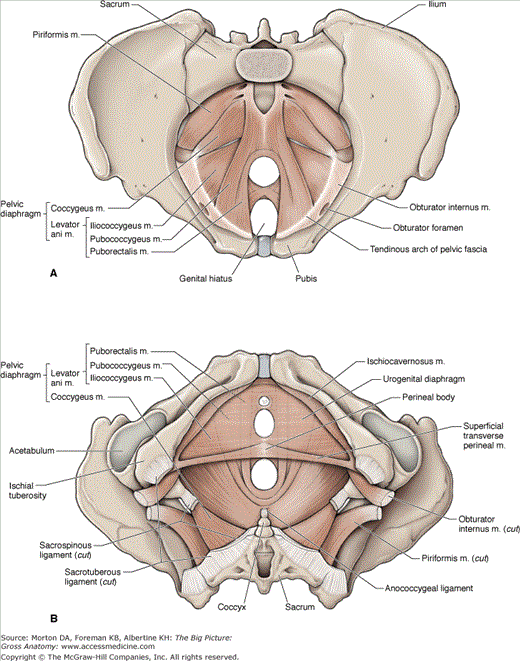Pelvic Floor
The pelvic diaphragm is formed by the union of the levator ani and the coccygeus muscles. A layer of fascia lines the superior and inferior aspects of the pelvic diaphragm (Figures 12-1A). The levator ani muscle consists of three separate muscles: pubococcygeus, puborectalis, and iliococcygeus.
The pelvic diaphragm circumferentially attaches along the pubis, lateral pelvic walls, and coccyx. The rectum pierces the center of the pelvic diaphragm, giving the appearance of a funnel suspended within the pelvis. In addition to the rectum, the urethra and the vagina (in females) and the urethra (in males) pierce the pelvic diaphragm.
Functions of the pelvic diaphragm are as follows:
- Closes the pelvic outlet.
- Supports the abdominopelvic viscera.
- Resists increases in intra-abdominal pressure.
- Controls the openings of the rectum, urethra, and vagina (e.g., helps retain or release feces during a bowel movement).
- Marks the boundary between the rectum and the anal canal.
 The complex organization of overlapping muscles and fascia cause the pelvic diaphragm to be susceptible to injury and damage, especially in women. Repetitive stresses, such as those that occur during labor and delivery, can stretch and damage the levator ani muscles and cause pelvic floor insufficiency and its associated clinical problems (e.g., uterine prolapse; urinary incontinence).
The complex organization of overlapping muscles and fascia cause the pelvic diaphragm to be susceptible to injury and damage, especially in women. Repetitive stresses, such as those that occur during labor and delivery, can stretch and damage the levator ani muscles and cause pelvic floor insufficiency and its associated clinical problems (e.g., uterine prolapse; urinary incontinence).
- Obturator internus muscle. Covers and lines most of the lateral wall of the pelvis. The obturator nerves and vessels and other branches of the internal iliac vessels course along the medial surface of the obturator internus muscle. The obturator internus muscle exits the pelvis through the lesser sciatic foramen and inserts on the greater trochanter of the femur and performs external hip rotation.
- Piriformis muscle. Covers most of the posterior wall of the pelvis. The piriformis muscle exits the pelvis through the greater sciatic foramen and inserts on the greater trochanter of the femur and performs external hip rotation. The sacral plexus of nerves is medial to the piriformis muscle.
Perineum
The perineum is the diamond-shaped region inferior to the pelvic diaphragm. The pubic symphysis, pubic arches, ischial tuberosities, and coccyx bound the perineum. An imaginary line between the ischial tuberosities divides the perineum into an anterior (urogenital) triangle and a posterior (ischioanal) triangle (Figure 12-2A). The urogenital triangle extends between the paired ischiopubic rami. The ischioanal triangle is the fat-filled area surrounding the anal canal.
The urogenital triangle consists of a superficial and a deep layer of fascia (Figure 12-2A–D), with a middle layer of skeletal muscle called the urogenital diaphragm.
The deep perineal space is filled by the muscles that comprise the urogenital diaphragm. The deep perineal space contains the following structures (Figure 12-2B and D):
- External urethral sphincter. This skeletal muscle voluntarily prevents urine from spilling from the bladder.
- Deep transverse perineal muscle.
- Bulbourethral (Cowper’s) gland. In males, this gland produces and secretes mucus, which lines the lumen of the urethra during ejaculation.
The superficial perineal space is the region inferior to the urogenital diaphragm and its inferior fascia, and is enclosed by the superficial perineal (Colles’) fascia (Figure 12-2A and C). The superficial perineal space contains erectile tissue, muscles, and neurovascular structures associated with the external genitalia. These structures will be covered in more detail in Chapters 13 and 14.
The ischioanal triangle contains a horseshoe-shaped fossa filled with fat and is known as the ischioanal fossa. The anal canal and its associated sphincters are in the center of the triangle.
The boundaries of the ischioanal fossa are as follows:
- Anterior. Posterior border of the urogenital triangle.
- Posterior. Gluteus maximus muscle and the sacrotuberous ligament.
- Lateral. Deep fascia of the obturator internus muscle, which condenses around the pudendal nerve (S2–S4) and the internal pudendal artery and vein, forming the pudendal (Alcock’s) canal. The inferior rectal vessels and nerves cross the fossa from the pudendal canal and supply the inferior portion of the rectum. The pudendal nerve and internal pudendal artery and vein exit the pudendal canal and course into the urogenital triangle to supply the structures in the triangle and the external genitalia.
- Floor. Deep fascia of the levator ani muscle.
Pelvic Vasculature
The common iliac arteries divide at the sacroiliac joints and become the external and internal iliac arteries. The external iliac arteries mainly serve the lower limb. The internal iliac arteries distribute blood to the pelvic walls and viscera (i.e., rectum, bladder, prostate, ductus deferens, uterus, uterine tubes, and ovaries). Additionally, these arteries distribute blood to the gluteal region, the perineum, and the medial compartment of the thigh.
The external iliac artery courses deep to the inguinal ligament, where it becomes the femoral artery (Figure 12-3A). The femoral artery is the principal blood supplier to the lower limb. Before it exits the pelvis, the external iliac artery gives rise to the inferior epigastric artery, which ascends vertically along the internal surface of the anterior abdominal wall.
The internal iliac artery divides into an anterior and a posterior trunk near the greater sciatic foramen (Figure 12-3A and B).
Branches from the anterior trunk supply the pelvic viscera, perineum, gluteal region, and medial compartment of the thigh. The branches off the anterior trunk of the internal iliac artery are as follows:
Stay updated, free articles. Join our Telegram channel

Full access? Get Clinical Tree





